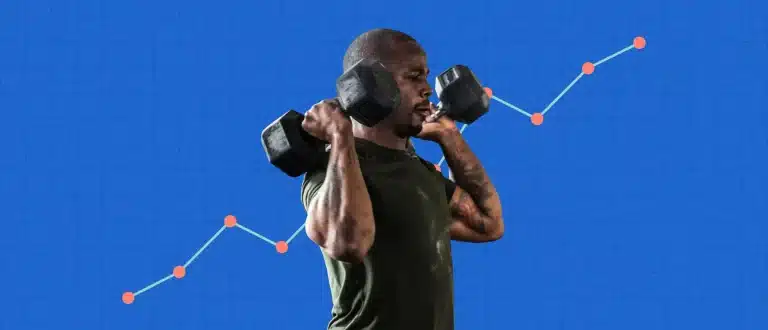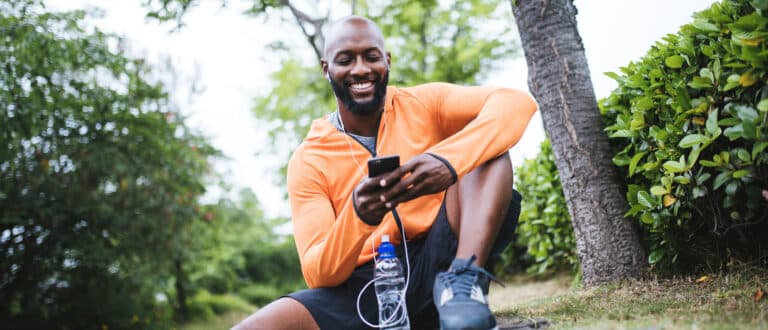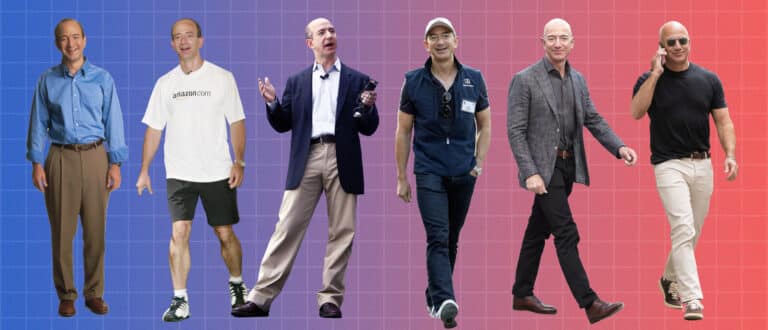The 8 Health Habits Rhonda Patrick Relies on for Brain Health and Longevity
Cell biologist Rhonda Patrick, Ph.D., is known for her uncanny ability to break down complex scientific topics. She makes it almost too easy to understand the latest research about longevity and optimizing health. And for us, that’s healthspan gold.
Her website Found My Fitness promotes physical and mental improvement to take your longevity to the next level. With past experience at St. Jude’s Children’s Research Hospital and the Salk Institute for Biological Sciences, Patrick has amassed a social following of nearly one million eager anti-agers ready to improve their health.
While her wheelhouse is mitochondrial function, don’t underestimate Patrick’s knowledge of other longevity-focused topics including micronutrients and aging, heat and cold exposure, and stress-reducing weapons, like mindfulness and sleep.
And she takes her own advice to a whole new level.
Here’s everything we know about Rhonda Patrick’s health habits, from time-restricted eating, to a steamy sauna, and how she overcame anxiety in an unconventional way.
She Practices Time-Restricted Eating
Unlike intermittent fasting—which involves calorie restriction—time-restricted eating allows you to eat as much as you want during your eating window, Patrick wrote on her Found My Fitness blog.
“I usually start my clock as soon as I wake up,” she told The Tim Ferriss Show, “and go by the strictest of definitions. If it’s not water, it breaks the fast.”
She follows a 10-hour eating window and fasts for 14 hours. If she’s up for it, “I eat within an eight- or nine-hour time window and fast for 15 or 16 hours during the night.”
Patrick tweeted one 2020 study that found time-restricted eating within a 10-hour window may reduce your risk for developing certain health conditions, including cancer and cognitive decline (1).
Time-restricted eating within a 10-hr window & fasting for 14-hrs a day without restricting calories altered the body’s production of proteins consistent with a reduced risk of developing chronic conditions such as cancer, diabetes, and cognitive decline. https://t.co/Z95wnNrtZO
— Dr. Rhonda Patrick (@foundmyfitness) April 21, 2020
On an episode of The Joe Rogan Experience, she also touted the benefits of time-restricted eating towards gaining muscle mass and better endurance.
“If I eat within a nine-hour window and I go for a run the next morning, my endurance is very noticeably improved, like extremely noticeably improved,” she said.
She’s a Regular in the Sauna
“I started doing sauna in 2009 in graduate school,” Patrick told the Huberman Lab podcast. “I used to go to the sauna before going into the lab, and I started noticing that I was, all of a sudden, able to handle stress better.”
Which makes sense because saunas release endorphins—“feel good” hormones—that reduce stress and improve wellbeing.
Now, the sauna is a regular part of Patrick’s routine. While she enjoys a post-workout sauna session, one benefit she loves is how the sauna affects her memory.
“I remember things better after thinking about them in the sauna,” she told MedCram.
Her theory: Sauna activates emotional arousal that helps solidify a memory.
Patrick cranks the sauna up to about 186 degrees Fahrenheit and will sit for 20 to 30 minutes with humidity around 10 to 20 percent, she told MedCram.
“It really works,” she said, not only for your physical health and fitness but also for your focus and mental health.
She Loves HIIT
You’ll most likely find Patrick spinning out HIIT workouts on her Peloton bike. “I use Peloton because I like the instructor there telling me what to do and then me competing with everyone else,” she told the Huberman Lab podcast.
She aims for three to four HIIT workouts a week of 20 seconds on, 10 seconds off lasting 10 minutes, “because it’s efficient and I push my ass. I push myself really hard,” she said.
As someone focused on longevity, research supports Patrick’s HIIT obsession, as it’s been shown to decrease your risk of death (2,3).
On top of her grueling HIIT training, Patrick mixes in aerobic exercise, strength training, yoga, and ballet exercises, she told The Tim Ferriss Show.
HIGH INTENSITY EXERCISE AND T
She Takes Fish Oil for Brain Health and Anti-Aging
“I personally think [fish oil] is one of the most powerful, antiinflammatory, dietary lifestyle things that we can get relatively easily that is going to powerfully modulate the way you think, the way you feel, and the way you age,” she told the Huberman Lab podcast.
“I take four grams a day. I take two grams [of EPA] in the morning and I take two grams [of DHA] in the evening,” she told the Huberman Lab podcast. Eicosapentaenoic acid (EPA) and docosahexaenoic acid (DHA) are the two main omega-3 fatty acids found in fish.
She told The Tim Ferriss Show that the benefits of fish oil on brain health and aging are two reasons why she’s been taking them for almost a decade.
Research confirms that omega-3s improve cognitive function and brain health and reduce oxidative stress and inflammation. Both of which increase your risk for age-related diseases, including heart disease, type 2 diabetes, and Alzheimer’s (4,5,6).
If you’re looking to optimize your omega-3 intake, Patrick told Andrew Huberman that 2 grams is a strong starting point.
She Loves a Smoothie
Drinking a smoothie is a “pretty important lifestyle hack,” which Patrick uses to prioritize nutrient density—the number of nutrients you get for the calories you consume—she told The Tim Ferriss Show.
“I often enjoy wedging a smoothie sometimes as a partial meal substitute that is particularly focused on cramming in some extra servings of some fruits and vegetables,” she said.
Her self-coined “micronutrient smoothie” triples the number of vegetables she takes in on a daily basis.
“Basically I grab various combinations of vegetables, and sometimes a few fruits to balance it out, drop them all into a powerful blender or food processor and drink, drink it down,” she said.
Lucky for us, she’s not shy about sharing her recipes. After her midday blueberry, kale, and avocado smoothie, “my brain always feels supercharged,” she said in an Instagram post.
Want to give her green drink a try?
- 1 organic spinach bunch
- 4 large organic celery stalks
- 1 bunch of organic Italian parsley
- 1 organic cucumber
- 1 small organic lemon
- Desired amount of organic ginger
She’s done this micronutrient smoothie hack four to five times per week for many years and noticed the amount of vegetables she buys quadruples, upping her intake of micronutrients for healthier development, disease prevention, and overall wellbeing.
HEALTH HABITS
She Tracks Her Blood Sugar Levels
Thanks to her continuous glucose monitor (CGM).
“I learned a lot from it as well in terms of foods that I have a bigger spike to, spike to [after a meal],” she said on her podcast. “And other lifestyle factors that affect my fasting blood glucose,” she said.
CGM’s are primarily used by people with diabetes, although people without diabetes have taken to these trackers to measure their blood sugar throughout the day and night—despite one camp of experts claiming they’re a waste of time and money.
For Patrick, using a CGM monitors her ratio of sugar to fiber. “One of the things that’s really consistent with lowering the [post-meal] glucose response is more fiber,” she told The School of Greatness podcast. Because your body can’t break down and absorb fiber, it doesn’t spike your blood sugar levels and keeps them in check.
She’s Doesn’t Have Time for Processed Sugar
One of the easiest lifestyle changes to make with the biggest impact on health is to cut out refined sugar including any processed cookies, cakes, and candies, Patrick told The Tim Ferriss Show.
Studies show refined sugar increases inflammation, raises bad cholesterol, and increases telomeres—a biomarker for aging—that make you look older.
One 2018 study even found that drinking too many sugar-sweetened beverages lowered testosterone levels in men ages 20 to 39 (7).
“In my opinion, the best thing you can do is cut [refined sugar] out,” she said. “You’ll be so much healthier by just cutting out this one thing.”
She Overcame Anxiety in an Unconventional Way
Patrick had a lot of fear over public speaking and “social interaction is a little anxiety-inducing for me,” she said on her podcast. But she found her inner comedian by telling jokes to random people in the mall.
“Most of the time, people would laugh at my bad jokes and look at me like I’m insane,” she said. “I did get over that anxiety of having people think I’m crazy or just that awkwardness of talking to someone.”
By embracing discomfort, she now has no problem communicating science to people on such a public platform. “It worked for me,” she said.
References
1. Mindikoglu, A.; et al. (2020). Intermittent fasting from dawn to sunset for 30 consecutive days is associated with anticancer proteomic signature and upregulates key regulatory proteins of glucose and lipid metabolism, circadian clock, DNA repair, cytoskeleton remodeling, immune system and cognitive function in healthy subjects.
2. Matthews, C.; et al. (2022). The hare and the tortoise: physical activity intensity and scientific translation.
3. Stensvold, D.; et al. (2020). Effect of exercise training for five years on all cause mortality in older adults—the Generation 100 study: randomised controlled trial.
4. Derbyshire, E. (2018). Brain Health across the Lifespan: A Systematic Review on the Role of Omega-3 Fatty Acid Supplements.
5. Satizabal, C.; et al. (2022). Association of Red Blood Cell Omega-3 Fatty Acids With MRI Markers and Cognitive Function in Midlife.
6. Kiecolt-Glaser, J.; et al. (2012). Omega-3 supplementation lowers inflammation in healthy middle-aged and older adults: A randomized controlled trial.
7. Chen, L.; et al. (2018). Sugar-sweetened beverage intake and serum testosterone levels in adult males 20–39 years old in the United States.

Want exclusive content? Our digests do that.
The best science-backed, expert-driven health and lifestyle content delivered to your inbox, weekly.














